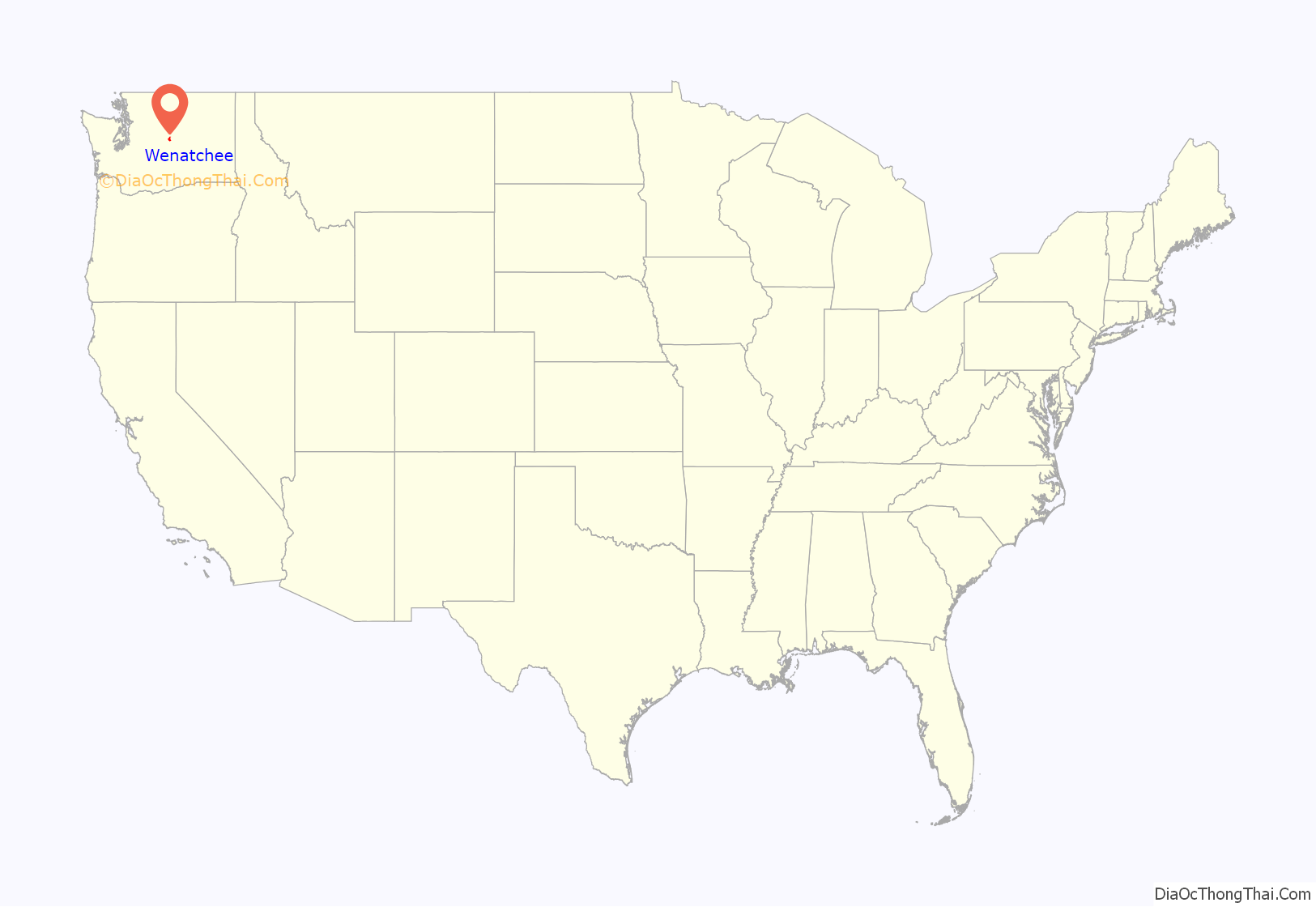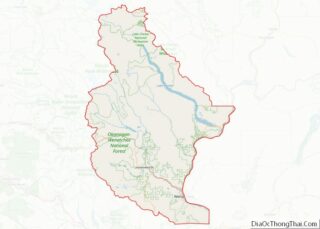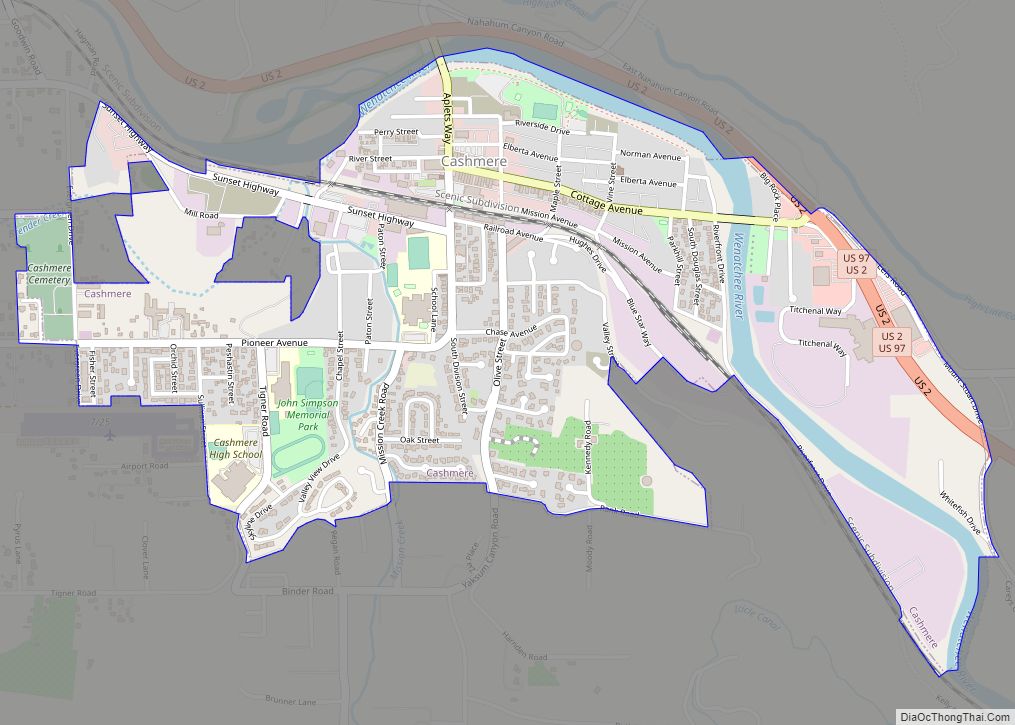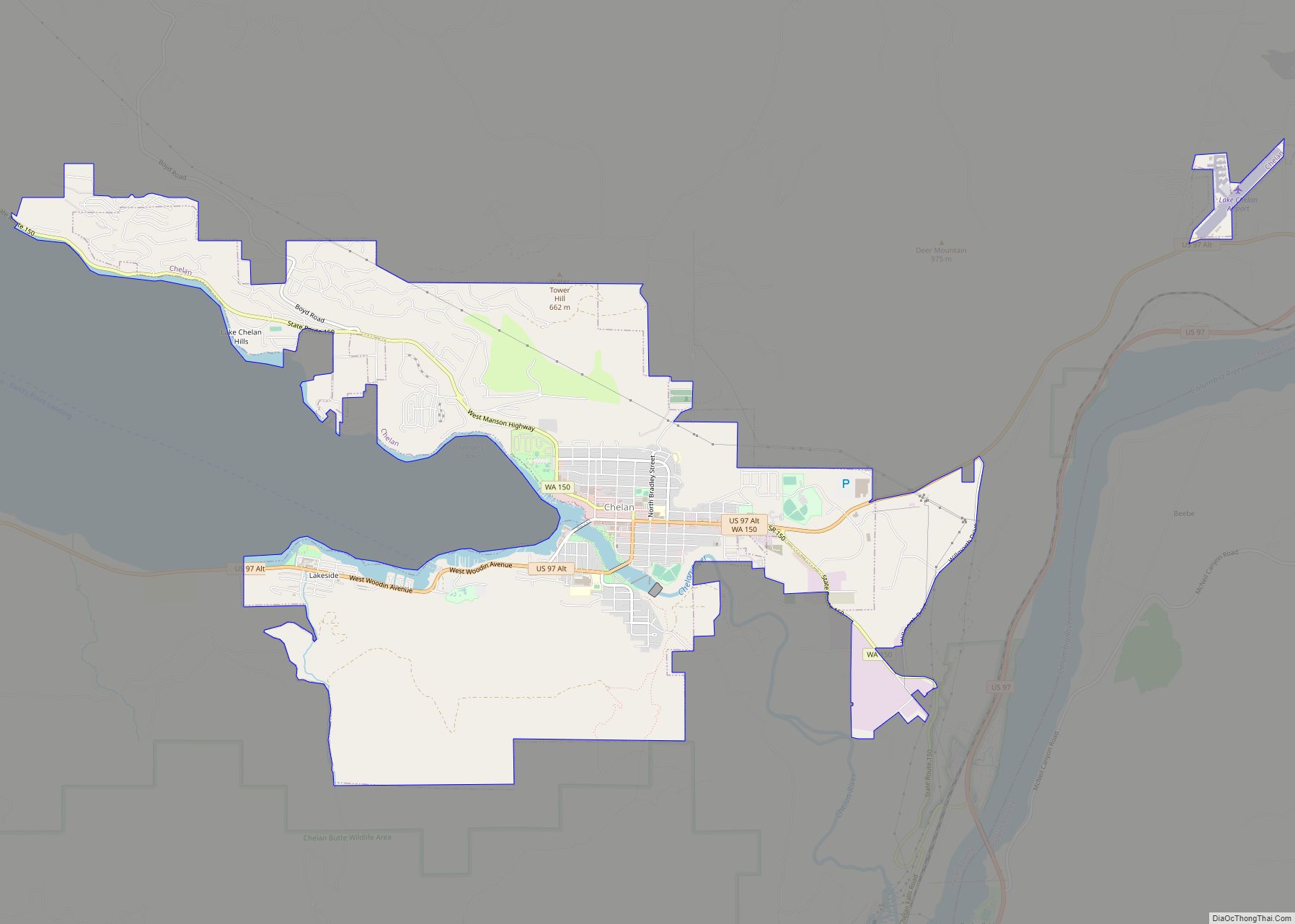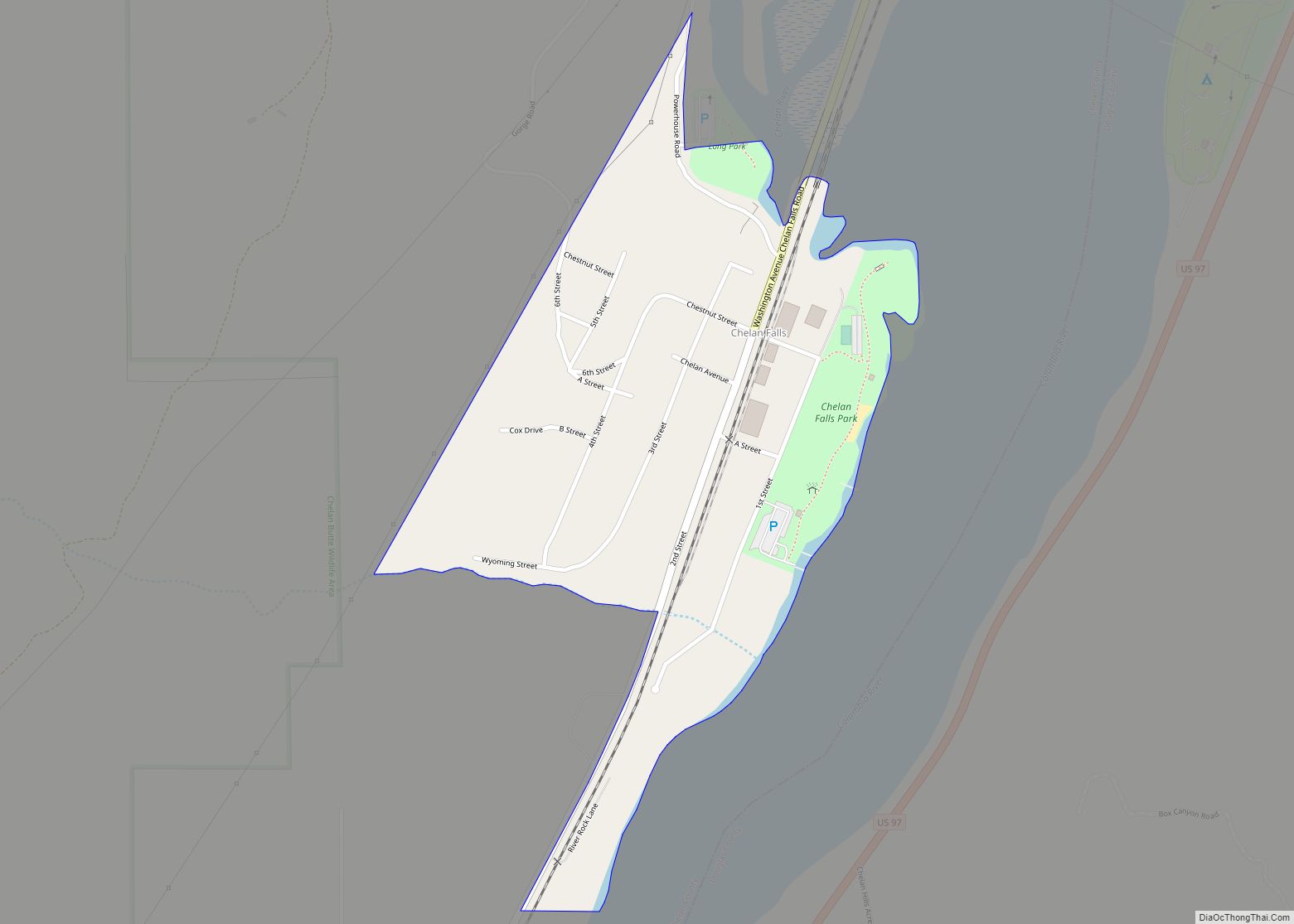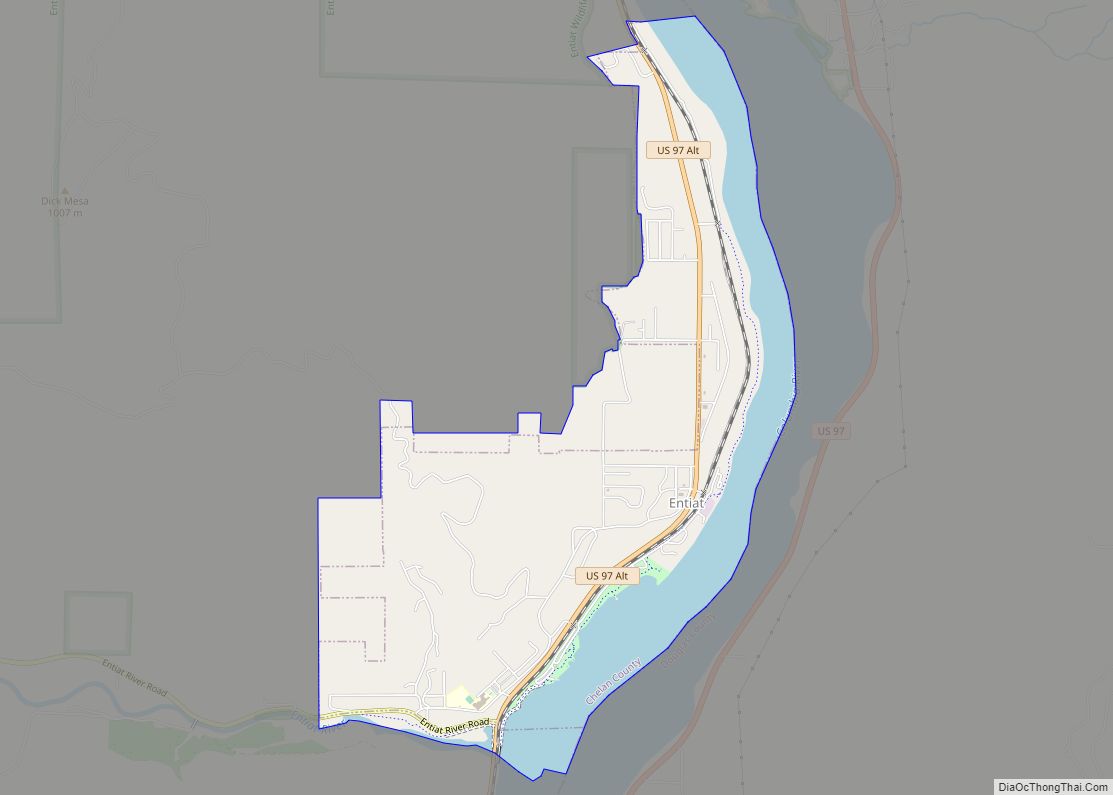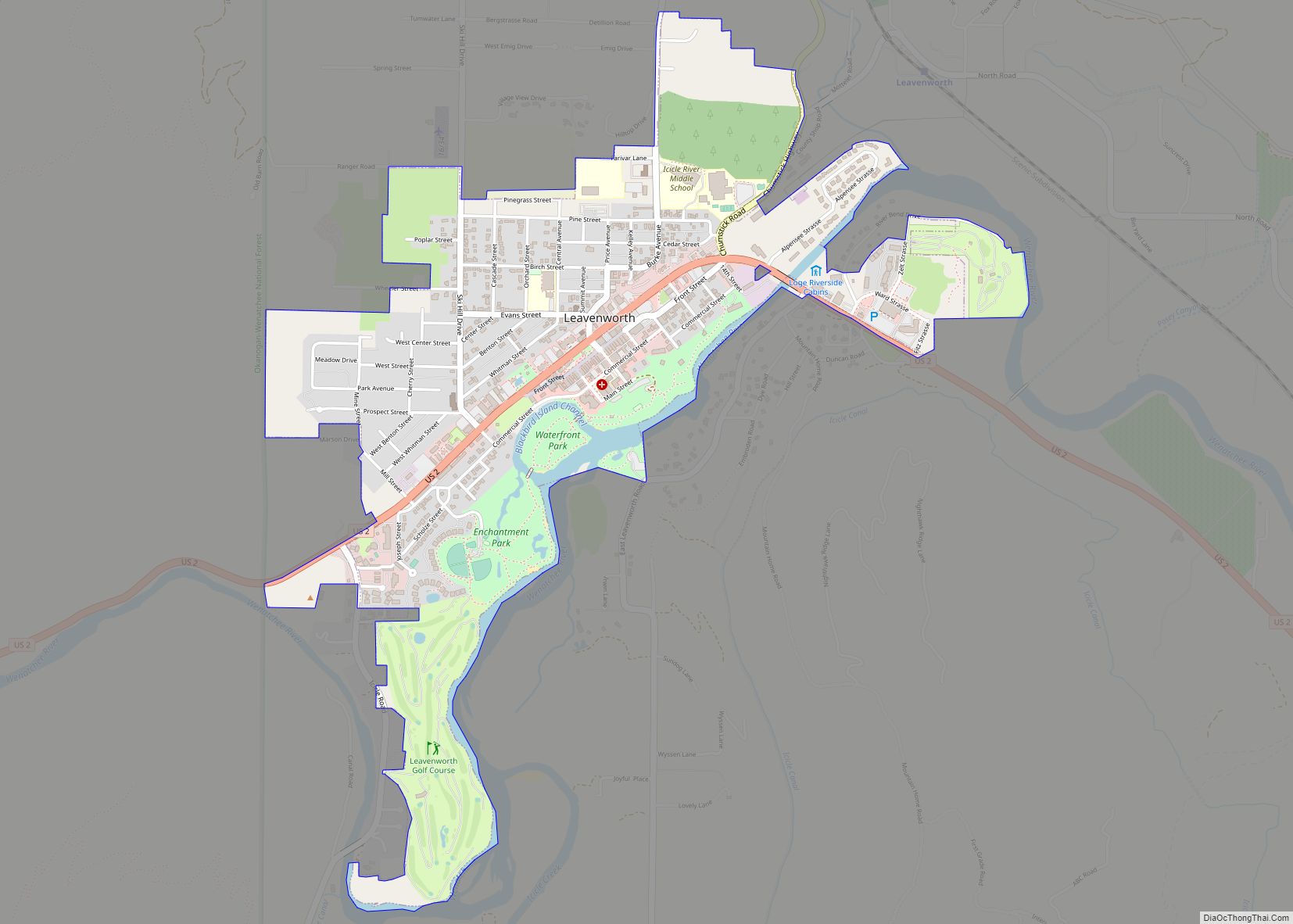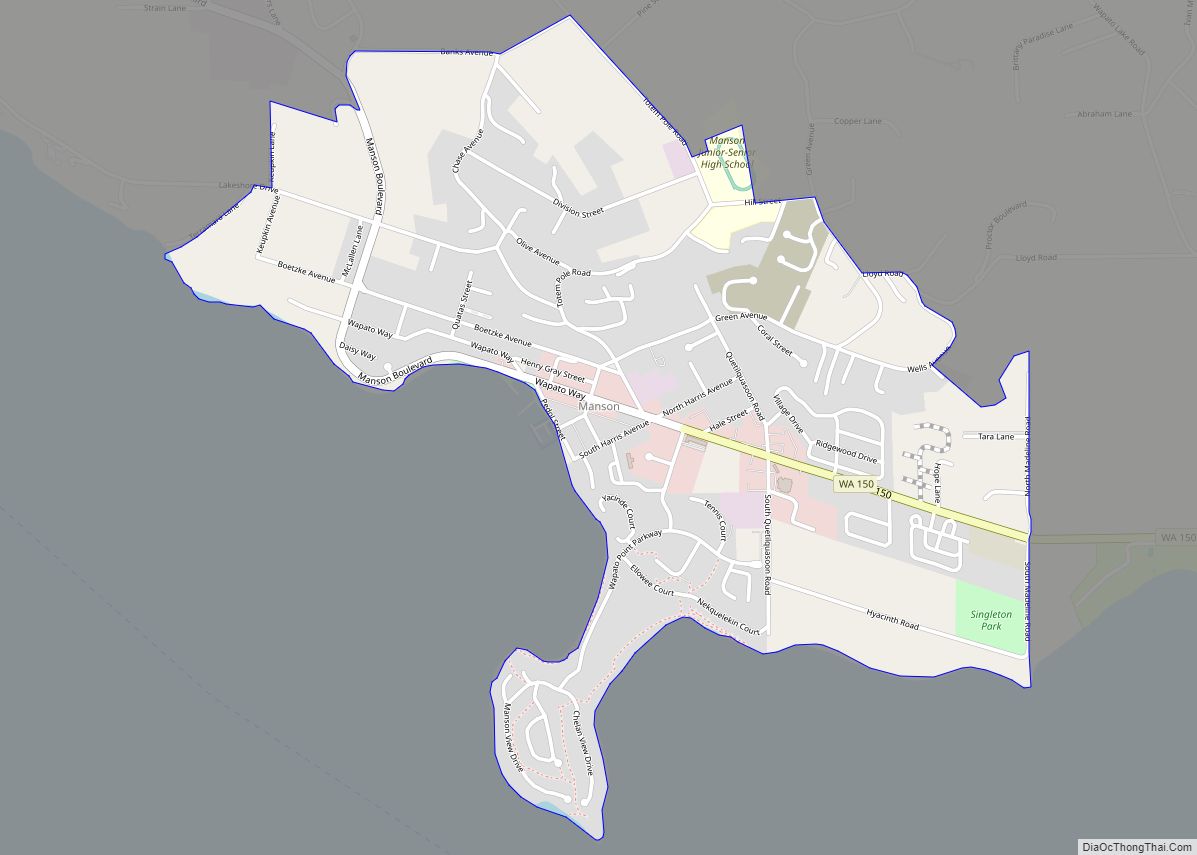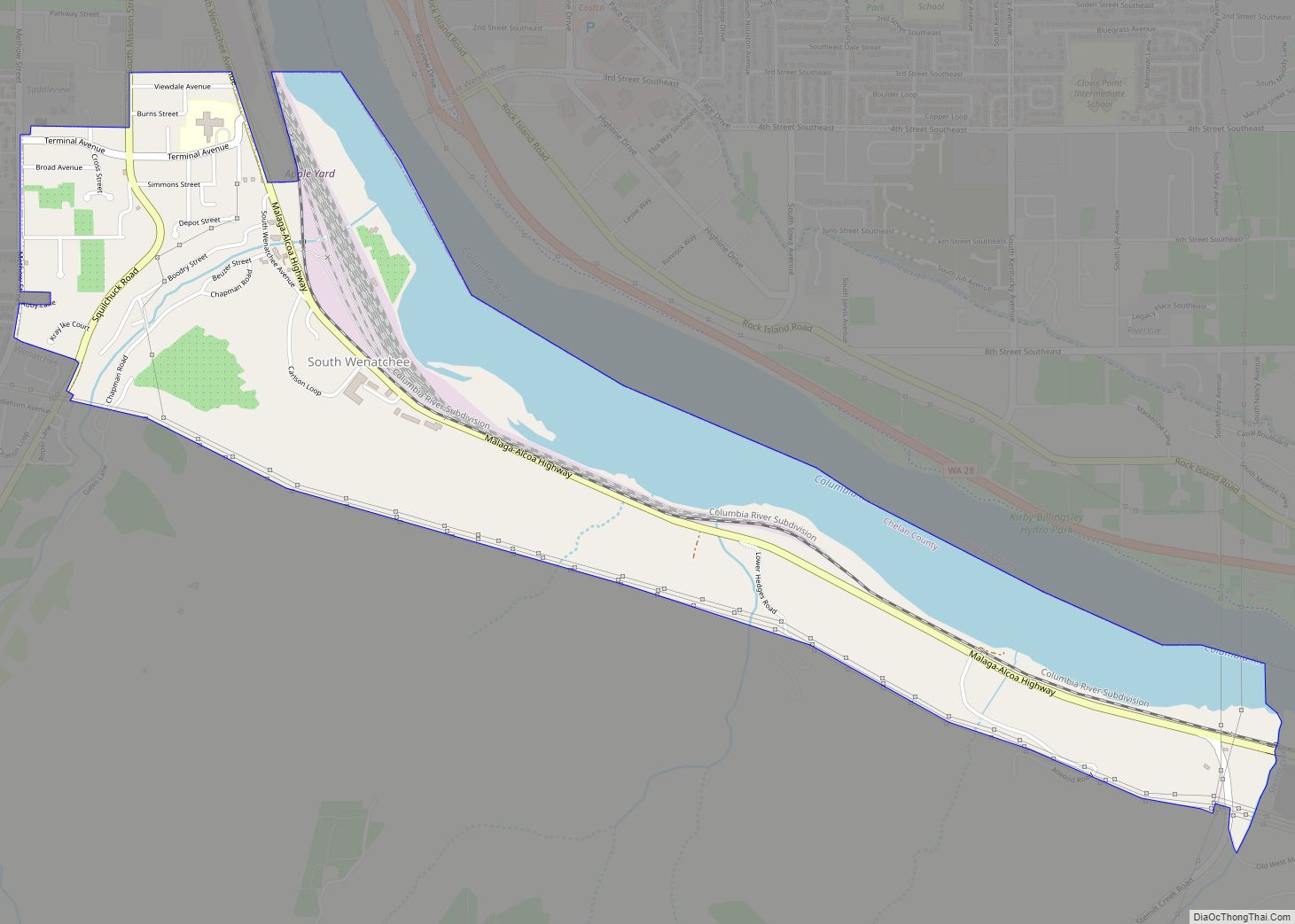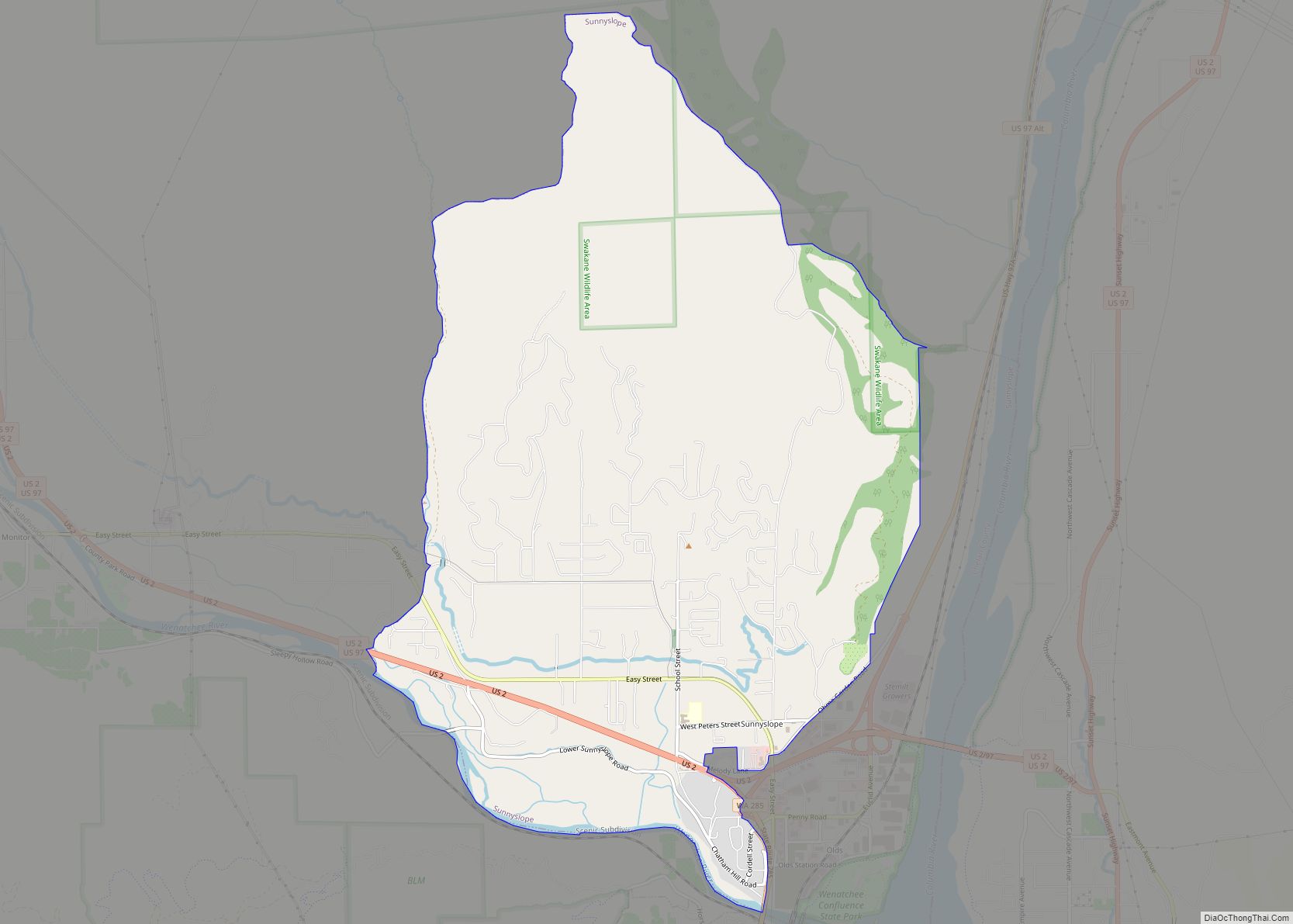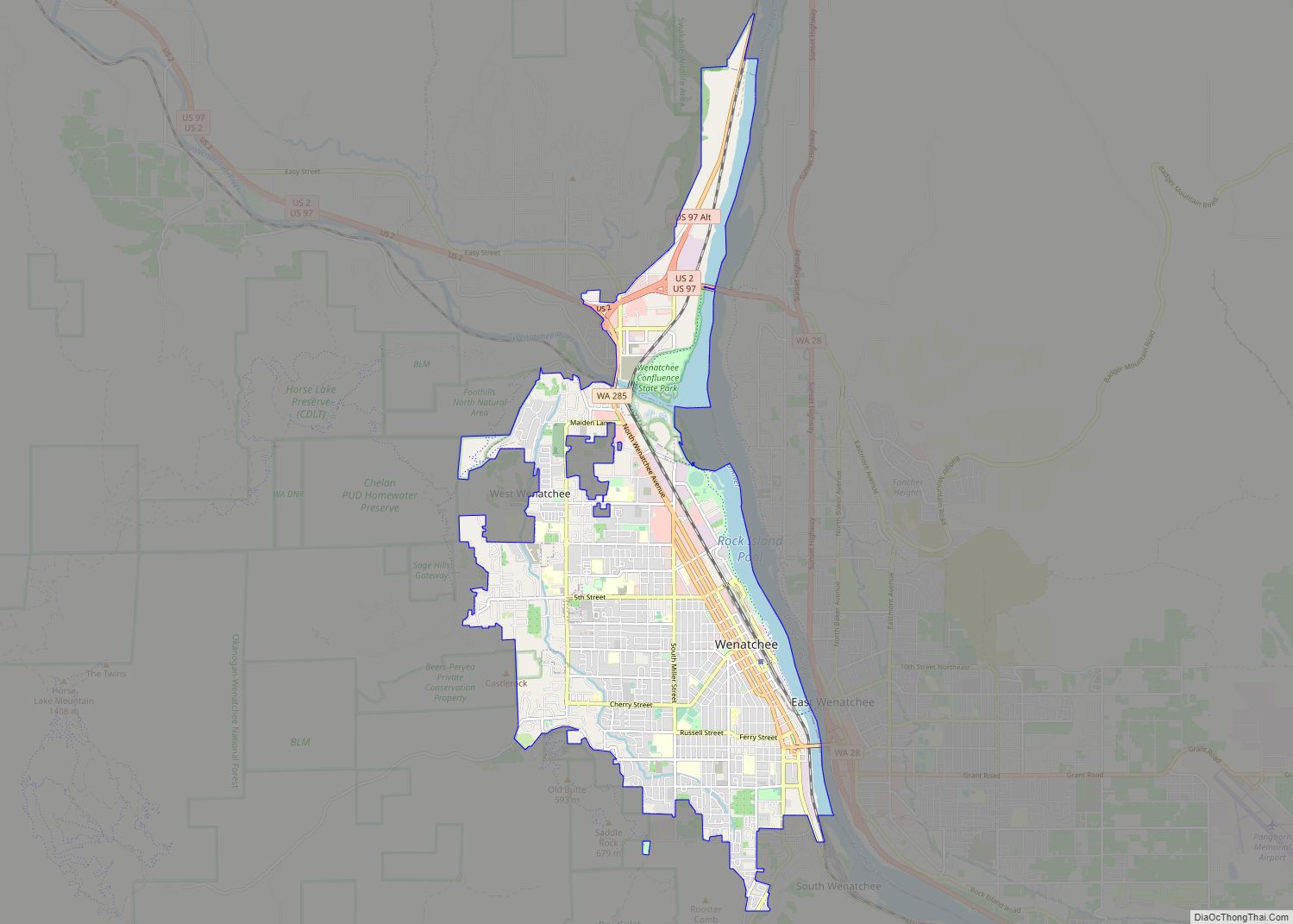Wenatchee (/wɛˈnætʃiː/ weh-NA-tchee) is the county seat and largest city of Chelan County, Washington, United States. The population within the city limits in 2010 was 31,925, and has increased to 35,508 as of 2020. Located in the north-central part of the state, at the confluence of the Columbia and Wenatchee rivers near the eastern foothills of the Cascade Range, Wenatchee lies on the western side of the Columbia River, across from the city of East Wenatchee. The Columbia River forms the boundary between Chelan and Douglas County. Wenatchee is the principal city of the Wenatchee–East Wenatchee, Washington Metropolitan Statistical Area, which encompasses all of Chelan and Douglas counties (total population around 110,884). However, the “Wenatchee Valley Area” generally refers to the land between Rocky Reach and Rock Island Dam on both banks of the Columbia, which includes East Wenatchee, Rock Island, and Malaga.
The city was named for the nearby Wenatchi Indian tribe. The name is a Sahaptin word that means “river which comes [or whose source is] from canyons” or “robe of the rainbow”. Awenatchela means “people at the source [of a river]”. The city of Wenatchee shares its name with the Wenatchee River, Lake Wenatchee and the Wenatchee National Forest.
Wenatchee is referred to as the “Apple Capital of the World” due to the valley’s many orchards. The city is also sometimes referred to as the “Buckle of the Power Belt of the Great Northwest”. The “Power Belt of the Great Northwest” is a metaphor for the series of hydroelectric dams on the Columbia River. Rock Island Dam is located nearest to the middle of this “belt”, and so was labeled the “Buckle”. This saying is printed at the top of every issue of Wenatchee’s newspaper, The Wenatchee World, but is no longer in common use elsewhere.
| Name: | Wenatchee city |
|---|---|
| LSAD Code: | 25 |
| LSAD Description: | city (suffix) |
| State: | Washington |
| County: | Chelan County |
| Incorporated: | February 29, 1892 |
| Elevation: | 780 ft (237 m) |
| Land Area: | 10.57 sq mi (27.39 km²) |
| Water Area: | 0.91 sq mi (2.36 km²) |
| Population Density: | 3,249.17/sq mi (1,254.56/km²) |
| ZIP code: | 98801#&98807 |
| Area code: | 509 |
| FIPS code: | 5377105 |
| GNISfeature ID: | 1527897 |
| Website: | www.wenatcheewa.gov |
Online Interactive Map
Click on ![]() to view map in "full screen" mode.
to view map in "full screen" mode.
Wenatchee location map. Where is Wenatchee city?
History
Prehistoric era
Archeological digs in nearby East Wenatchee have uncovered Clovis stone and bone tools dating back more than 11,000 years, indicating that people migrating during the last Ice Age spent time in the Wenatchee area. The Columbia River and nearby mountains and sagebrush steppes provided an ample supply of food. Clovis points are on display at the Wenatchee Valley Museum & Cultural Center and research findings are available through the Wenatchee World.
Indigenous villages and early settlers
Several indigenous villages existed in the area prior to and during Anglo American exploration. The village Nikwikwi’estku was a fishing and gathering camp located in present-day downtown Wenatchee. In 1811, North West Company surveyor David Thompson encountered a group of Native American horsemen at Wenatchee and was invited into a village with huts, the largest measuring 209 feet long. Fur traders document friendly relations through the mid 19th century, even during the smallpox epidemic of 1817 and food shortages in 1841.
During the Yakima War in 1856, US Army Colonel Wright intervened on a possible alliance between Yakama and Wenatchi tribes by removing the Wenatchi to Kittitas. The resulting march was estimated to include 1,000 horses and extend five miles long. A contingent stayed behind to fish at Wenatchapam Fishery in preparation for winter.
In 1863, Father Respari, a Catholic priest, began his missionary work with local Native Americans. He was followed some 20 years later by Father De Grassi, who built a log cabin on the Wenatchee River near the present town of Cashmere. Throughout the 19th century, other white settlers came to homestead the land.
Wenatchee was platted in September 1888 and officially incorporated as a city on January 7, 1893. Frank and Belle Reeves founded The Wenatchee Advance, the city’s first newspaper, in 1891. The 1900 U.S. Census counted 451 residents.
Continued growth
The Great Northern Railway completed its railroad line between St. Paul, Minnesota, and Seattle in 1893. Its route through the Wenatchee Valley was significant to the development of this region. The railroad not only provided passenger travel to and from Wenatchee, but it provided for freight service for shipments of wheat, apples, and other products to out-of-state markets.
By the early 20th century, the Wenatchee Commercial Club, now the Wenatchee Valley Chamber of Commerce, was advertising the region as the “Home of the World’s Best Apples.” The tree fruit industry provided the economic backbone for the region for a century and still is an important source of revenue.
On May 22, 1910, the Wenatchee free speech fight occurred when members of the Industrial Workers of the World (IWW) were arrested for speaking in the street in front of the local hall of the Socialist Party of America. The town had freed imprisoned IWW members by June; however, tensions resumed in September 1911 when police raided a house rented by six IWW men and arrested twenty-five migrant workers found carrying IWW literature. Again, the men were all quickly released.
In 1922, a Ku Klux Klan chapter of nearly 100 men demanded that black residents leave on threat of violence. By 1923 they hosted meetings of up to 400 members and burned a large cross above Fancher airfield in East Wenatchee. The Wenatchee chapter hosted the 1926 state Klan convention and marched in the Apple Blossom Parade. In the wave of anti-Filipino sentiment, Filipino immigrant workers were targeted by violence and deportation through the late 1920s.
On October 5, 1931, Clyde Pangborn and his copilot Hugh Herndon landed their airplane, named the Miss Veedol, in the hills of East Wenatchee, and thus became the first aviators to fly nonstop across the Pacific Ocean. The 41-hour flight from Sabishiro Beach, Misawa, Aomori Prefecture, Japan, won them the Harmon Trophy for the greatest achievement in flight of 1931. Miss Veedol‘s propeller is on display at the Wenatchee Valley Museum & Cultural Center.
In 1936, with the completion of Rock Island Dam, Wenatchee was protected from the summer flooding of the Columbia River, and the first of 14 hydroelectric projects on the Columbia began generating electric power. The reservoirs thus generated also made it possible to irrigate hundreds of thousands of acres of farmland in the Columbia Basin.
Modern era
In 1975, Stemilt Growers moved its headquarters from nearby Stemilt Hill to Olds Station, Wenatchee. The company grows, packs and ships tree fruit and would go on to become the largest fresh market sweet cherry shipper in the world.
Every year from the last week of April to the end of the first week of May, Wenatchee hosts the Washington State Apple Blossom Festival, which probably brings in the largest number of people Wenatchee sees annually, with the exception of migrant workers travelling for harvest. It features two relatively large parades: the Apple Blossom Youth Parade on the last Saturday in April and the Apple Blossom Grand Parade on the first Saturday in May, a food fair representing cuisine from around the world, and a traveling carnival.
The Wenatchee child abuse prosecutions in Wenatchee, Washington, also known as the “Wenatchee Witch Hunt”, that occurred in 1994 and 1995, are examples of the hysteria over child molestation in the 1980s and early 1990s.
In the early 1990s Wenatchee had a reputation as the “happy pill town” and “Happy Valley”, with psychologist James Goodwin, “the Pied Piper of Prozac”.
According to CNN’s Money Magazine, Wenatchee had the second fastest forecast real estate value growth in the country for June 2006–June 2007. In November 2018, USA Today listed Wenatchee as experiencing the 22nd highest employment growth in the country.
On July 29, 2013, a large wildfire spreading over 31 miles (50 km) south of Wenatchee occurred, affecting over 40 nearby homes.
The Riverfront Park Ice Arena closed its doors in July 2008, and Awaken Church was later opened at the site.
The Wenatchee Valley also boasts one of only two aluminum smelters remaining in the Northwestern United States, at the Alcoa plant in Malaga. The plant announced in November 2015 that it would be shutting down operations on January 5, 2016. Other growing areas of the regional economy are tourism and information technology.
Wenatchee Road Map
Wenatchee city Satellite Map
Geography
Wenatchee is located at the confluence of the Wenatchee and Columbia rivers in the Columbia Basin, just east of the foothills of the Cascade Range. Irrigation from the Columbia River and its tributaries allows for the large amount of agriculture in Wenatchee and the surrounding areas.
The city of Wenatchee is bordered by the Wenatchee River on the north, the Columbia River to the east, and the Wenatchee Mountains to the south and west. These ridges and peaks form a wall around the western and southern sides of the city. According to the United States Census Bureau, the city has a total area of 8.04 square miles (20.82 km), of which 7.77 square miles (20.12 km) is land and 0.27 square miles (0.70 km) is water.
Climate
Wenatchee experiences a semi-arid climate (Köppen BSk) with cold winters and hot, dry summers.
See also
Map of Washington State and its subdivision:- Adams
- Asotin
- Benton
- Chelan
- Clallam
- Clark
- Columbia
- Cowlitz
- Douglas
- Ferry
- Franklin
- Garfield
- Grant
- Grays Harbor
- Island
- Jefferson
- King
- Kitsap
- Kittitas
- Klickitat
- Lewis
- Lincoln
- Mason
- Okanogan
- Pacific
- Pend Oreille
- Pierce
- San Juan
- Skagit
- Skamania
- Snohomish
- Spokane
- Stevens
- Thurston
- Wahkiakum
- Walla Walla
- Whatcom
- Whitman
- Yakima
- Alabama
- Alaska
- Arizona
- Arkansas
- California
- Colorado
- Connecticut
- Delaware
- District of Columbia
- Florida
- Georgia
- Hawaii
- Idaho
- Illinois
- Indiana
- Iowa
- Kansas
- Kentucky
- Louisiana
- Maine
- Maryland
- Massachusetts
- Michigan
- Minnesota
- Mississippi
- Missouri
- Montana
- Nebraska
- Nevada
- New Hampshire
- New Jersey
- New Mexico
- New York
- North Carolina
- North Dakota
- Ohio
- Oklahoma
- Oregon
- Pennsylvania
- Rhode Island
- South Carolina
- South Dakota
- Tennessee
- Texas
- Utah
- Vermont
- Virginia
- Washington
- West Virginia
- Wisconsin
- Wyoming
